A Taste for the Beautiful: The Evolution of Attraction
Air Date: Week of March 2, 2018
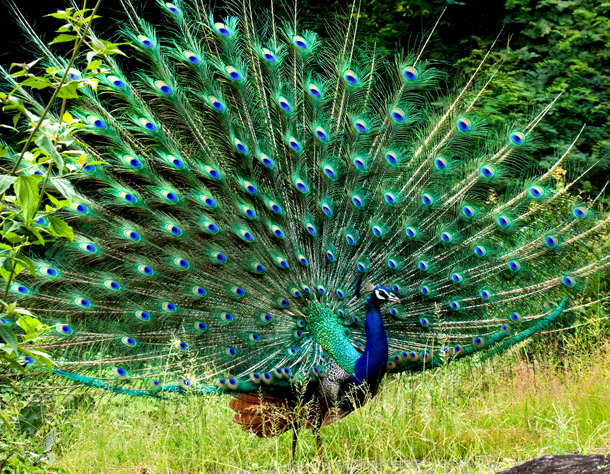
A male peacock fans its eye-catching tail feathers while courting a female. Charles Darwin was confounded as to why such a fanciful trait would exist – seemingly in contradiction of his theory of natural selection -- and wrote to a friend, “the sight of a feather in a peacock's tail, whenever I gaze at it, makes me sick!” (Photo: N.A. Naseer, Wikimedia Commons CC BY-SA 2.5 IN)
A peacock’s eye-catching tail; extra notes in a frog’s love song; pheromones of a female bee - all these exploit sexual preferences hoping to give the suitor a better shot at mating and passing on his genes. In this conversation with Living on Earth’s Helen Palmer, evolutionary biologist Michael J. Ryan explains how sexual selection shapes the appearance, songs, smells and behavior of most living things. Michael Ryan explains his arguments in the new book, A Taste for the Beautiful: The Evolution of Attraction.
Transcript
KAISER: It’s Living on Earth, I’m Jaime Kaiser.
DOERING: And I’m Jenni Doering, we’re in for Steve Curwood. Charles Darwin is famous for developing the theory of evolution by means of natural selection, the so-called survival of the fittest, but he realized that surviving was only part of the challenge.
KAISER: For the birds and the bees and virtually all complex life forms to pass on their genes they need to attract a mate, and that’s spurred elaborate, extravagant displays – think fancy feathers, or huge antlers or complex songs.
DOERING: In his new book, A Taste for the Beautiful: The Evolution of Attraction, biologist Michael J. Ryan picks up where Darwin left off, to help explain these alluring traits. Living on Earth’s Helen Palmer spoke with him about his new book.
PALMER: So, Michael Ryan, your book "A Taste for the Beautiful" is concerned not with the survival of the most fit but with Darwin's second most celebrated book, "The Descent of Man and Selection in Relation to Sex". You note that Darwin said that thinking about the peacock's tail made him sick. Given how beautiful the peacock's tail is, what was Darwin's problem?
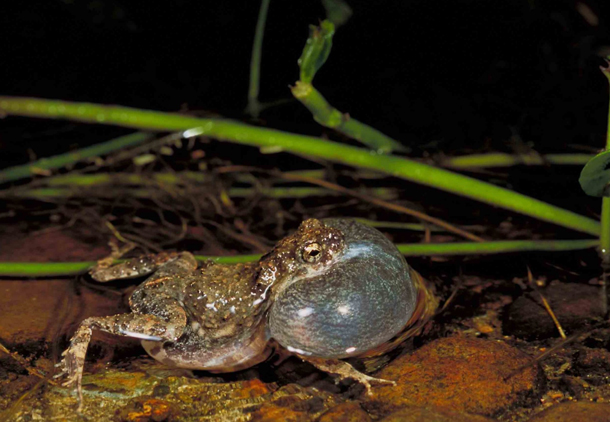
A calling male túngara frog at a typical breeding site in central Panama. The male’s large vocal sac is as distinctive as his complex call. (Photo: Ryan Taylor)
RYAN: What made him sick was cognitive dissonance, I think. He had this wonderful theory, natural selection, that explained how organisms were able to evolve adaptations for survivorship, and then he was confronted with all of these traits of animals and also too of plants that if anything would be maladaptive, and the peacock's tail was a great example of that. With the male having to fly with a tail that’s sometimes in excess of one meter is not going to help him survive, in fact, it's going to increase his mortality. So, this is what Darwin confronted: a major challenge to his idea of natural selection, and this is what drove him to then concentrate on, not survivorship, but reproductive success.
PALMER: So, why is sexual selection so different from natural selection?
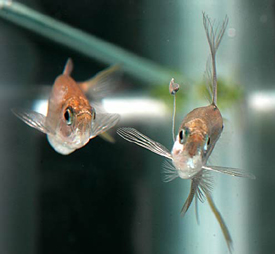
For some creatures, food is pretty sexy stuff. Above, a male swordtail characin (right) extends its pectoral fin-ray with a piece of flesh that resembles a food item to the female, on the left. Once the female is attracted to this faux food item, the male initiates courtship. (Photo: Nicolas Kolm)
RYAN: There's two components to fitness, two things individuals need to do to get their genes into the next generation, and one is survive, of course, because as I say in the book, road kills don't mate, you have to be alive to mate, but if you live a long and happy life but never mate, then again, your genes are not getting into the next generation. So, selection favors animals that have some optimum combination of survivorship, favored by natural selection, and mating success, favored by sexual selection.
So, if we think of the peacock example, like there's a range of tails sizes amongst the males, the males with the short tails might survive much better, but would have very low mating success. The males with the very long tails might be very attractive to the females, but they're not going to live long enough to be able to attract females. So, what evolves, what we assume and what theoretical models show, is the extent of development of the sexual trait should reach a tipping point between the cost of predation, or the energetic cost, and then the benefit of being more attractive to mates.
PALMER: So, the Túngara frog is your particular organism, or an organism you’ve spent a lot of time with, and particularly you've spent a lot of time listening to its calls. I believe you have a call that we can actually listen to.
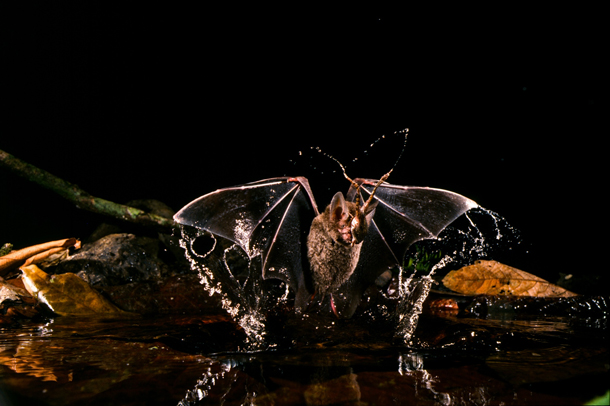
A fringe-lipped bat with a túngara frog, its favorite prey in central Panama. This bat can locate a calling frog by homing in on the call alone. (Photo: Merlin Tuttle | MerlinTuttle.org)
RYAN: Yes, so I will play first a chorus, a small chorus of frogs, of Túngara frogs, and it will immediately inform us about how complicated the chorus is. So, I'll play that first.
[TÚNGARA FROG CHORUS]
RYAN: Now, from that recording it's hard to discern that the males have a call with two components, a ‘whine’ followed by a ‘chuck’, and males can make the ‘whine’ by itself or they can add up to seven ‘chucks’. So, what I'll play now is a call that we've isolated from a single male and we'll hear a call that contains a ‘whine’ with zero ‘chucks.’
[TÚNGARA FROG CALL]
RYAN: A whine with one chuck.
[ANOTHER TÚNGARA FROG CALL]
RYAN: A whine with two chucks.
[A THIRD TÚNGARA FROG CALL]
RYAN: And a whine with three chunks.
[A FOURTH TÚNGARA FROG CALL]
RYAN: So, those are the calls.
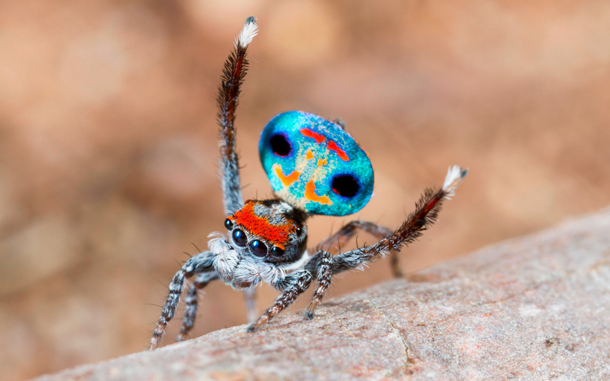
The peacock spider is a type of jumping spider; the male’s colorful display is reminiscent of a peacock. His beautifully adorned abdomen is only raised when the male courts the female, at which time he waves it back and forth in an invitation to mate. (Photo: Jurgen Otto)
PALMER: So, why do you think that they decided to start adding their chucks in the first place?
RYAN: There is strong selection for these displaying males to be conspicuous, and the ‘chuck’ makes them especially conspicuous because of the females' brain. So, we have one ear on each side of our head, but frogs have two ears, two on the left and two on the right, and they're sensitive to different frequencies. So, the ‘whine’ -
[RYAN IMITATES THE CALL]
- that stimulates one of the inner ear organs, and that tells the females that the male is the correct species.
The females have another ear though and this ear in the Túngara frog happens not to be being used for communication. Most of the close relatives of the Túngara frogs only produce ‘whines’, so they're only giving information to the female in only one ear. Now, the chuck perfectly matches the sensitivity of the second ear. So, now the females hearing a ‘whine’ and a ‘chuck’ and neural stimulation is passing from ear into the brain and then when we measure the response of the females’ brain to these calls we see that the brain areas that are involved in sexual reproduction are much more active when she hears both of these syllables compared to only one syllable.
PALMER: So, if the female likes the ‘chuck’ so much, why doesn't everybody just add lots of ‘chucks’?
RYAN: Right, that was one of the first questions we addressed when we started the study so we thought well there must be some cost to the males to making a ‘chuck’. So, one of the first things we did was we measured how much energy it costs to call, and it costs a lot to call. The male’s metabolic rate increases by about 150 percent when it calls, but to add a ‘chuck’ doesn't really cost them much. But to add a ‘chuck’ increases their sexual attraction to the females by 500 percent. So, it's a little burp at the end of a call that's quite salient to the females, it's a powerful sexual signal.
Then a colleague of mine, Merlin Tuttle, a bat biologist, found a bat with a frog in its mouth, and Tuttle wondered if the frog was an important part of its diet. Merlin and I started to work together and we found that the bat, which we now call the frog-eating bat, not only eats frogs but it finds the frogs by homing in on their mating calls. And just like the female frogs, they're attracted to calls with ‘chucks’ over calls without ‘chucks’, and calls with more ‘chucks’ to calls with fewer ‘chucks’. The females are looking for a mate, and the bats are looking for a meal.
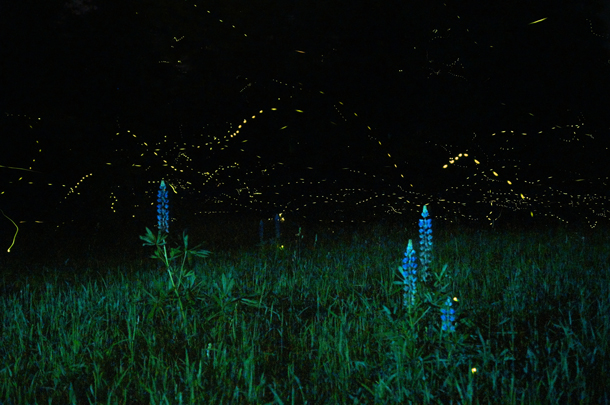
Male and female fireflies engage in spectacular nocturnal courtship displays. The patterns of flashes are distinctive for each species. (Photo: Mike Lewinski, Wikimedia Commons CC BY 2.0)
Now, what's interesting about the Túngara frog call is that the complexity of the call is not fixed. They can vary it. They can decide to make no ‘chucks’ or they can decide to make up to seven ‘chucks’. And they're sensitive to predation risk. If a bat flies over the pool for quite a long time, the frogs are very reluctant to add any ‘chucks’ to their call. So, they're acting as if they know what the predation risk is.
PALMER: That's amazing that they actually can think it through like that.
You write that the old saying, that opposites attract, that there's actually a biological basis to it in terms of immunity. Can you explain about how an individual of a species can tell which other individuals are better for building their immunity?
RYAN: Right, you know we should first just remember that it's critically important for individuals to mate with members of their own species. So, in that sense they're similar. They have complimentary genes, but when it comes to the immune system, selection actually favors the genes of our immune system to be very variable. The more variable they are, the more pathogens they can recognize. So, if a female could do a gene scan of her mate and a gene scan of herself, what she would want to do is look at these immune genes, we call them MHC for short, and she would know what her genes looked like and then she could look at another male's genes and then she should decide to mate with the male whose immune genes are most different from hers.
Well, of course they can't do that. So, what do they do? They smell, they use odor cues. We know a lot about this in rodents. There are cues in the urine that are related to the immune genes. So, by smelling the urine, the females can determine, it seems, whether the male has immune genes similar to their own or different from their own, and in these studies they preferentially mate with males whose immune genes are different.
PALMER: And you make the point that this is actually something that works with humans as well; it's not just opposites attracting in the animal kingdom.
RYAN: Yes, there are these classic experiments called stinky T-shirt experiments where they ask males to wear T-shirts and not shower for a few days. The women are then asked to smell the T-shirts and then rank the attractiveness of the males. Then the researchers analyze the immune genes of everybody involved in the experiment, and the females prefer the odors of males with immune genes more different than theirs.
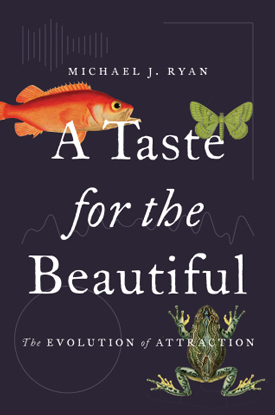
Michael J. Ryan is the author of A Taste for the Beautiful: The Evolution of Attraction. (Photo: courtesy of Princeton University Press)
But there's a caveat, a very important caveat here. This only happens if the females are not taking birth control pills. If they're taking birth control pills, that induces a physiological scenario of being pregnant. Then the females actually prefer odors related to immune genes that are more similar to their own. So, someone suggested a tricky scenario in which made a man and a woman fall in love, they get married and then they decide to have children. So, the woman stops taking the pill. Does this make her all of a sudden very unattractive to her partner. I don't know of any studies that have addressed this, but that's been a suggestion that's been around for a while.
PALMER: It casts a pall over the birth control pills if they run the risk of making you less fit parents.
RYAN: Oh exactly, exactly! For good or for bad, natural selection doesn't work as strongly on current human populations as it does on animal populations.
PALMER: Now, you talk about how important it is to mate with a creature of your own species as opposed to a creature of some other species, and yet you’ve also pointed out how in some cases there are species which can actually get benefits from mating with species that aren't actually the same as theirs. You talk about Orchid bees, for instance. Can you talk about that? Because that is a fascinating idea.
RYAN: So, a lot of plants attract pollinators with nectar, and the pollinators feed on the nectar, and then in the process of doing that some pollen clings to their body. They then go to another plant to get nectar and the pollen falls off their body and fertilizes the plant. So, that's a - that's a classic mutualism. The bee’s getting something out of it, the pollinator’s getting something out of it, and the plant’s getting something out of it. But there's this large group of orchids that are called deceptive orchids. They don't produce nectar, but bees still pollinate them. So, why would a bee do that? Well, the shapes of the flowers are similar to the silhouette of the bees, and in some of the orchids, they produce a chemical that is very similar to the sexual pheromone of the species, and in fact, is even more potent.
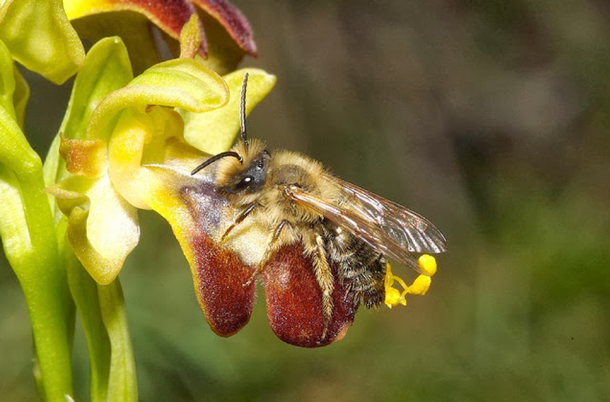
A bee orchid trying to mate… with an orchid! Although this seems like a waste of time, the bee’s sexual attraction to this bee-shaped orchid limits the risk that he will pass up the rare chance to mate an actual female bee. (Photo: Nicolas J. Vereecken)
So, it seems that the bees are attracted to the orchid because they're duped into thinking that it's actually a female. So, the male is attempting to have sex with the plant, and while he's doing that he's not getting a nectar reward. He's not getting any reward but he's picking up pollen. So, then he flies off and the next time he's duped by the same species of orchid, he tries to mate with it and then the pollen comes off and fertilizes the orchid. So, then the question is, “Well, why would a bee not just figure out that this is a plant and not mate with it?” Well, the bees could become much more discriminating, let's say, but if they become much more discriminating it's certainly possible that they might pass up some females if they're being too discerning, and in these Orchid bees, the females are very hard to come by. Our guess is that that would be a more costly mistake than the probably very little cost to actually trying to have sex with a plant.
PALMER: There's a very nice passage at the very end of the book on page 170. I think it kind of encapsulates your thesis in this book. Could you read the last two paragraphs please?

Ryan writes in his book, “Why is a rainbow ‘beautiful’? Why does the mere refraction of light into bands of color inspire awe?” (Photo: Danesman1, Wikimedia Commons CC BY-SA 3.0)
RYAN: Yes. [READING] Of course beauty is not restricted to sexual beauty. The perspective I present here also leads us to wonder how the idiosyncrasies and quirks in our own brains influence our own appreciation of beauty in a grander sense, as it applies beyond sex. Why is a rainbow beautiful? Why does the mere refraction of light into bands of color inspire awe?
We can pose the same question about a work of art, a field of flowers, and an expertly executed move on the football field. Might any of these percepts of beauty be a side effect of our sexual aesthetics; or, alternatively, can our appreciation of beauty in other domains influence what we find to be sexually beautiful? What is it about our senses, our brains, and our cognitive architecture that gives us an appreciation for beauty all around us? Why does beauty matter so much?
PALMER: That's very lovely. It's a very nice summing up of the question of the aesthetics and why it gives us so much pleasure.
RYAN: Thank you, thank you.
PALMER: Michael J. Ryan teaches at the University of Texas and is the author of the new book "A Taste for the Beautiful: The Evolution of Attraction".
KAISER: Michael Ryan spoke with Living on Earth’s Helen Palmer.
Links
Living on Earth wants to hear from you!
Living on Earth
62 Calef Highway, Suite 212
Lee, NH 03861
Telephone: 617-287-4121
E-mail: comments@loe.org
Newsletter [Click here]
Donate to Living on Earth!
Living on Earth is an independent media program and relies entirely on contributions from listeners and institutions supporting public service. Please donate now to preserve an independent environmental voice.
NewsletterLiving on Earth offers a weekly delivery of the show's rundown to your mailbox. Sign up for our newsletter today!
 Sailors For The Sea: Be the change you want to sea.
Sailors For The Sea: Be the change you want to sea.
 The Grantham Foundation for the Protection of the Environment: Committed to protecting and improving the health of the global environment.
The Grantham Foundation for the Protection of the Environment: Committed to protecting and improving the health of the global environment.
 Contribute to Living on Earth and receive, as our gift to you, an archival print of one of Mark Seth Lender's extraordinary wildlife photographs. Follow the link to see Mark's current collection of photographs.
Contribute to Living on Earth and receive, as our gift to you, an archival print of one of Mark Seth Lender's extraordinary wildlife photographs. Follow the link to see Mark's current collection of photographs.
 Buy a signed copy of Mark Seth Lender's book Smeagull the Seagull & support Living on Earth
Buy a signed copy of Mark Seth Lender's book Smeagull the Seagull & support Living on Earth

